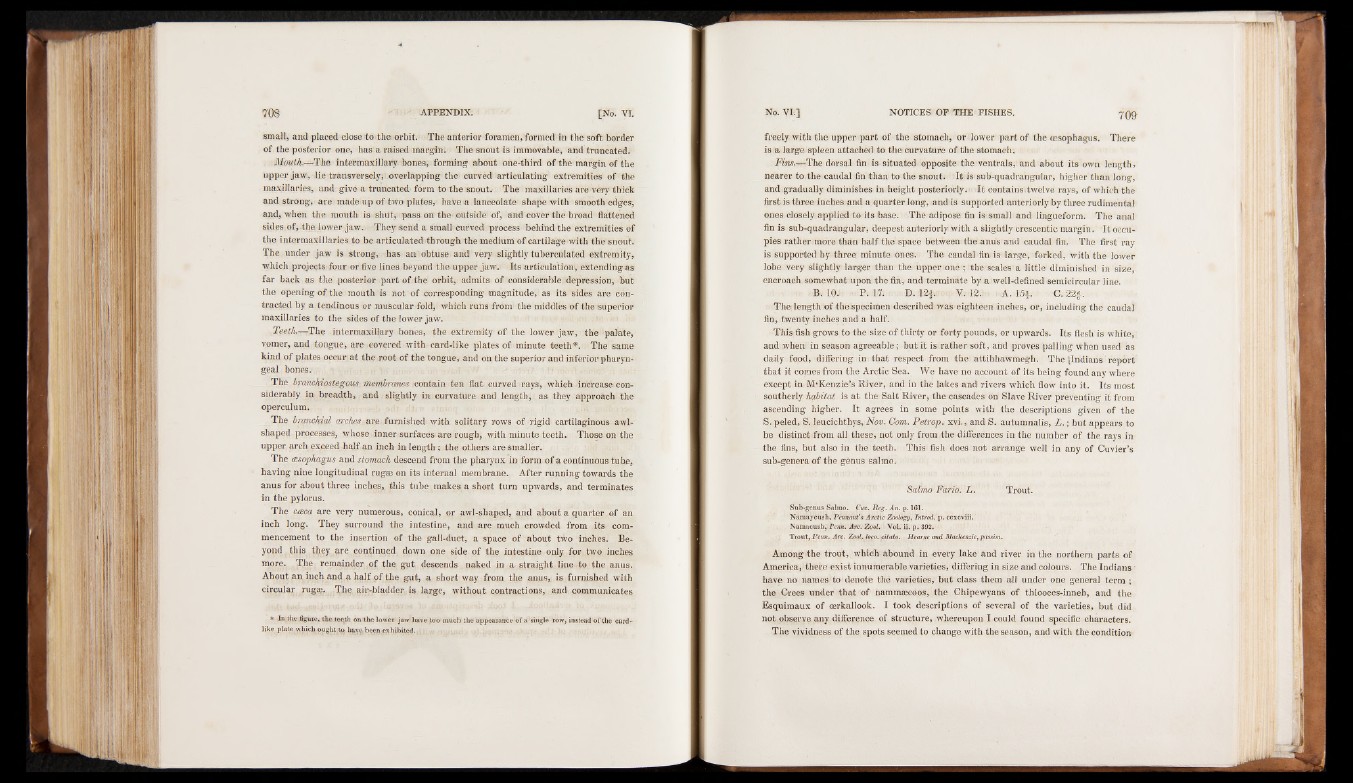
small, and placed close to the orbit. The anterior foramen, formed in the soft border
of. the posterior one, has a raised margin. The snout is immovable, and truncated.
Mouth.—The intermaxillary bones, forming about one-tliird of the margin of the
upper jaw, lie transversely*'.overlapping the curved articulating extremities of the
maxillaries, and give a truncated form to the snout. The maxillaries are very thick
and strong, are made up of two plates, have a lanceolate shape with smooth edges,
and, when the mouth is shut; pass on the outside of, and cover the broad flattened
sides of,-the lower jaw. They send a small curved process behind the extremities of
the intermaxillaries to be articulated through the medium of cartilage with the snout.
The under jaw is strong, has an-obtuse and very slightly tuberculated extremity,
which projects four or five lines beyotid the upper jaw. Its articulation, extending as
far back as the posterior part of the orbit, admits of considerable depression, but
the opening of the mouth is not of corresponding magnitude, as its sides are contracted
by a tendinous or muscular fold, which runs from the middles of the superior
maxillaries to the sides of the lower jaw.
Teeth.—The intermaxillary bones, the extremity of the lower jaw, the palate,
vomer, and tongue, are covered with card-like plates of minute teeth*. The same
kind of plates occur at the root of the tongue, and on the superior and inferior pharyngeal
bones.
The branchiostegcncS; membranes contain ten flat curved rays, which increase considerably
in breadth, and slightly in. curvature and length, as they approach the
operculum.
The branchial arches..are furnished with solitary rows of rigid cartilaginous awl-
shaped processes, w'hose inner surfaces are rough, with minute teeth. Those on the
upper arch exceed half an inch in length; the others are smaller.
The (esophagus and stomach descend from the pharynx in form of a continuous tube,
having nine longitudinal rugae on its internal membrane. After running towards the
anus for about three inches, this tube makes a short turn upwards, and terminates
in the pylorus.
The caca are very numerous, conical, or awl-shaped, and about a quarter of an
inch long. They surround the intestine, and are much crowded from its commencement
to the insertion of the gall-duct, a space of about two inches. Beyond
this they are cpntinued down one side of the intestine only for two inches
more.. The rem ailer ,of the gut descends naked in a straight line to the anus.
About an^inch and a half of the gut, a short way from the anus, is furnished with
circular rugae...The ^-bladder is large, without contractions, and communicates
* figure, th e tee,th on <the low er jaw have too m uch th e appearance of a ’single row , instead of the cardlik
e plate \ybich pugh£,tfy h av ^ beep exhibited.
freely with the upper part of the stomach, or lower part of the oesophagus. There
is a large spleen attached to the curvature of. the stomach.
Fins.—The dorsal fin is situated opposite the ventrals, and about its own length»
nearer to the caudal fin than to the snout. It. is sub-quadrangular, higher than long,
and gradually diminishes in height posteriorly. It contains,twelve rays, of which the
first is three inches and a quarter long, and is supported anteriorly by three rudimental
ones closely applied to its base. The adipose fin is small and lingueform. The anal
fin is sub-quadrangular, deepest anteriorly with a slightly crescentic margin. It occupies
rather ;more than half the space between the anus and caudal fin. The first ray
is supported by three minute ones. The caudal fin is large, forked, with the lower
lobe very slightly larger than the upper one?; the scales a little diminished in size,
encroach somewhat upon the fin, and terminate by a well-defined semicircular line.
B. 10. P. 17. :• D. l^ n o j. V.d-2.1'! .■ A. 15f. C. 22f.
The length of the specimen described was eighteen inches, or, including the caudal
fin, twenty inches and a half.
This fish grows to the size of thirty or forty pounds, or upwards. Its flesh is white,
and when in season agreeable; but it is rather soft, and proves palling when used as
daily food, differing in that respect from the attihhaWmegh. The [Indians report
that it comes from the Arctic Sea. We have no account of its being found any where
except in M‘Kenzie?s River, and in the lakes and rivers which flow into it. Its most
southerly habitat is at the Salt River, the cascades on’ Slave River preventing it from
ascending higher. It agrees in some points with the descriptions given of the
S. peled, S. leucichthys,Nov. Com. Petrop. xvi., and S. autumnalis, L .; but appears to
be distinct from all these, not only from the differences in the number of the rays in
the fins, but also in the teeth. This fish does not arrange well in any of Cuvier’s
sub-genera of the genus sal mo.
Satmo Fafio. L. Trout.
Sub-genus Salmo. Cun. R eg. A n. p. 161.
Namaycush, Pennant’s Arctic Zoology, Introd. p. ccxcviii.
Namacush, Penn. Arc. Zool. Vol. ii. p. 392.
Trout, Penn. Arc. Zool, loco, citato. Hearne and Mackenzie, passim.
Among the trout, which abound in every lake and river in the northern parts of
America, there exist innumerable varieties, differing in size and colours. The Indians
have no names to denote thé varieties, but class them all under one general term ;
the Crees under that of nammaecoos, the Chipewyans of thlooees-inneh, and the
Esquimaux of cerkallook. I took descriptions of several of the varieties, but did
not observe any difference of structure, whereupon I could found specific characters.
The vividness of the spots seemed to change with the season, and with the condition